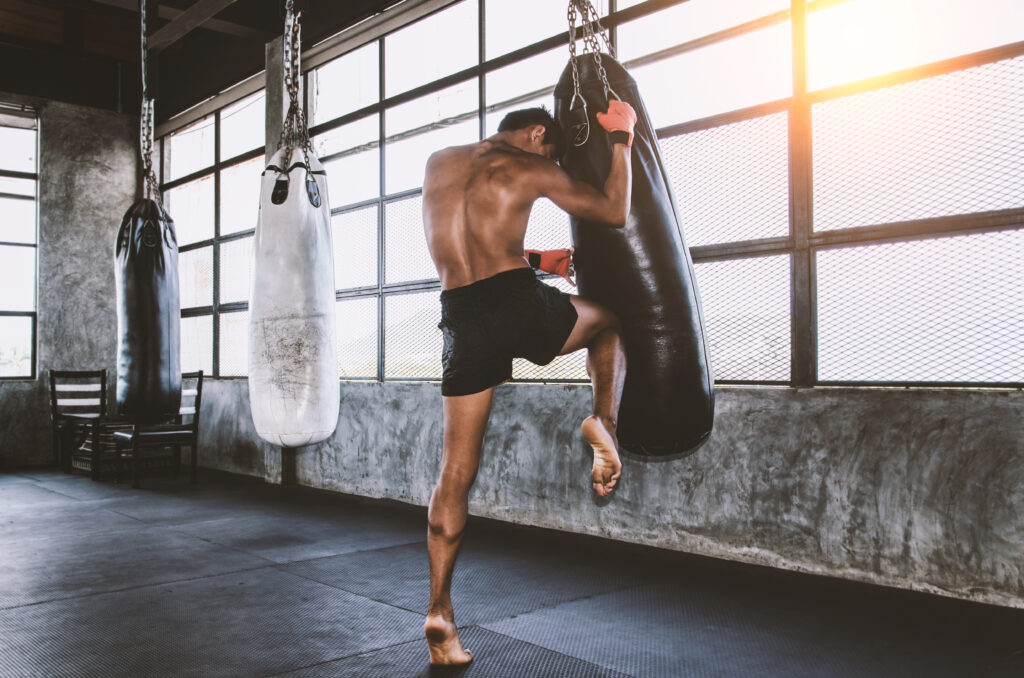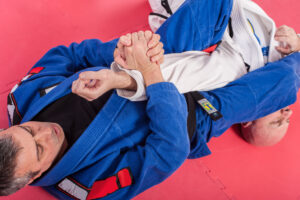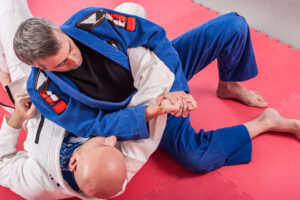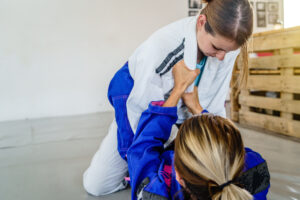I still remember my first MMA fight.
Twenty seconds in, my carefully practiced boxing combinations vanished from memory as my opponent shot for my legs.
Six months of striking practice, useless in an instant.
That humbling experience taught me what veterans already knew: in this sport, you’re only as good as your weakest discipline.
When Worlds Collide:
The BJJ and Muay Thai Synergy
Picture this: You’re landing crisp jabs and devastating leg kicks from your Muay Thai arsenal when suddenly your opponent changes levels.

Muay Thai Training In The Gym
Now you’re on your back, gasping for air, wondering if those BJJ classes you kept skipping might have been worth attending after all.
The fight game has evolved. The one-dimensional fighter – the pure boxer, the dedicated wrestler – is a relic of the past. Today’s champions effortlessly flow between striking and grappling, often specializing in the seamless transitions between the two. That’s where the BJJ and Muay Thai combination becomes lethal.
Think of these arts as different languages describing the same thing: controlled violence. Muay Thai speaks through explosive momentum, while BJJ whispers through patient pressure. Learning both doesn’t just give you more techniques – it fundamentally changes how you understand fighting itself.
Beyond Eight Limbs: Muay Thai’s Hidden MMA Value
Everyone talks about Muay Thai’s devastating strikes, but its secret MMA weapon lies elsewhere – in its clinch work. That awkward, sweaty, exhausting position where you’re chest-to-chest with your opponent isn’t just a transitional phase in Muay Thai; it’s a hunting ground.
When a pure boxer gets clinched, they panic. When a Muay Thai practitioner gets clinched, they smile. Those countless hours spent fighting for inside control, delivering short elbows and brutal knee strikes, translate perfectly to MMA’s clinch battles – exactly where striking and grappling blur together.
Then there’s the psychological toughening that comes from authentic Muay Thai training. After you’ve had your shin checked by a veteran Thai fighter – that sickening, nauseating pain that makes you question your life choices – an opponent’s threat to “break your arm” during a submission attempt somehow feels less intimidating.
The Chess Game: How BJJ Rewires Fighting Instincts
BJJ doesn’t just teach you how to grapple – it rewires your entire approach to physical conflict. Where striking arts often reward explosive aggression, BJJ punishes it. I’ve watched countless athletic powerhouses get systematically dismantled by smaller BJJ practitioners who simply understood positioning better.
The most valuable BJJ lesson for MMA isn’t the fancy submissions you see on highlight reels. It’s learning how to stay calm while someone is actively trying to dominate you. It’s developing what my coach calls “comfortable discomfort” – the ability to think clearly while exhausted, pressured, and trapped in seemingly bad positions.
This composure carries over to every aspect of fighting. The BJJ practitioner getting punched doesn’t panic; they analyze trajectory, timing, and openings – often seeing opportunities where others see only threats.
Real-World Integration: Beyond “Taco Tuesday, BJJ Thursday”
Let’s cut through the typical cross-training advice. Yes, schedule matters, but mental compartmentalization is your real enemy. The fighter who thinks “now I’m doing Muay Thai” and later “now I’m doing BJJ” will always struggle against someone who simply thinks “I’m fighting.”
Finding Your Connective Tissue
Instead of seeing these as separate arts, hunt for their connections. When drilling Muay Thai kicks, focus on the hip rotation that powers both your roundhouse and your BJJ sweeps. When practicing BJJ guard passes, recognize how the pressure concepts mirror the forward momentum of your Muay Thai clinch.
The transitions between disciplines contain your most valuable techniques. That moment when you catch a kick and your opponent hops awkwardly? That’s not just a Muay Thai counter opportunity – it’s a perfect BJJ takedown entry. The failed shot that leaves you in the clinch isn’t a failed wrestling attempt – it’s prime territory for Muay Thai knee strikes.
Embracing the Uncomfortable Middle
The hardest training days won’t be when you’re drilling your favorite techniques. They’ll be when you’re working the awkward transitions between striking and grappling – that chaotic middle ground where neither art exists in its pure form.
Seek out training partners who push you into this uncomfortable space. The BJJ player who makes you work from the clinch rather than pulling guard. The striker who stays just close enough to threaten takedowns without committing to them.
This middle ground – too close for clean striking, too unsettled for technical grappling – is where MMA fights are often won and lost. Master this space through deliberate cross-training, and you’ll find yourself comfortable exactly where your opponents are weakest.
Your MMA journey isn’t about becoming a master of two separate arts. It’s about forging something new from these ancient disciplines – something that’s uniquely yours, seamlessly integrated, and devastatingly effective where canvas meets mat.





